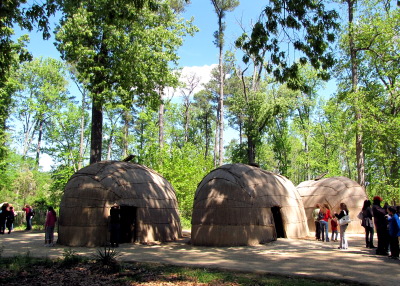Just before leaving Virginia, we had the chance to visit Jamestown.
Part of the site includes a re-creation of a Powhatan Indian village.
Artisans create tribal objects based on ancestral technologies. This young man was making a twine bag from natural fibers. The day we went, we also saw a woman making bone tools and another woman making necklaces from local shells. This part of the tour made me think of my friends from Twin Eagles Wilderness School.
The English fort is also re-created.
Artisans also re-create old English technologies, including blacksmiths, gunsmiths, gardeners, and this cook who allowed children to sample English recipes.
In the old English fort, I tried on a metal helmet that was typical of the Jamestown era. I immediately felt nauseated when I placed it on my head, though I'm not sure if my physical reaction was a result of the heaviness of the helmet or the history of military conquest associated with it.
Replicas of the English ships.
The Union Jack...
Virginia is a place of great natural beauty.
Away from the re-created sites, visitors can also see an archaeological site where the actual fort once stood. The site also includes several statues and monuments.
A statue of Pocahontas.
A statue of John Smith.
English graves along the James River.
Throughout Jamestown, one scarcely gets the impression that the arrival of the English was anything less than noble and heroic. When other ethnic groups are mentioned, they give the impression that the English, Powhatan Indians, and African slaves all somehow collaborated to create a new society. The truth is less inspirational.
On the plane ride home, I had the opportunity to read a biography of Pocahontas written by Helen Rountree, told largely from an Indian perspective. Through her writing, we discover the depravity of the English settlers in Virginia. Unlike the whitewashed myths we often learn in school, we see that the English literally went from village to village demanding food at gun point and eventually killing Indians who dared to object. For anyone who wants a more realistic history of early Virginia, I recommend the Rountree book.












No comments:
Post a Comment